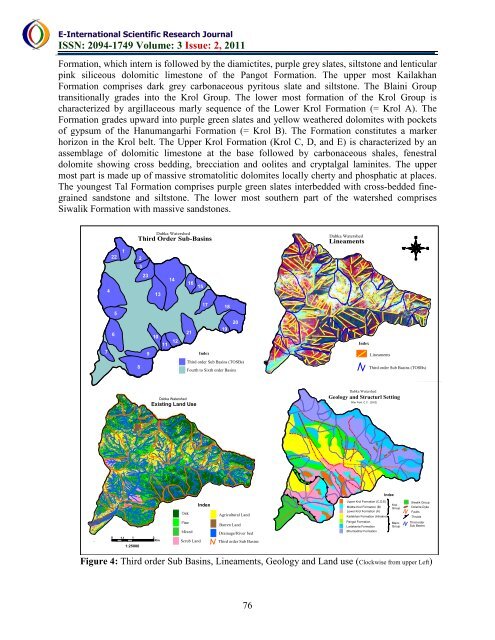download the full article here - E-International Scientific Research ...
download the full article here - E-International Scientific Research ...
download the full article here - E-International Scientific Research ...
Create successful ePaper yourself
Turn your PDF publications into a flip-book with our unique Google optimized e-Paper software.
E-<strong>International</strong> <strong>Scientific</strong> <strong>Research</strong> Journal<br />
ISSN: 2094-1749 Volume: 3 Issue: 2, 2011<br />
Formation, which intern is followed by <strong>the</strong> diamictites, purple grey slates, siltstone and lenticular<br />
pink siliceous dolomitic limestone of <strong>the</strong> Pangot Formation. The upper most Kailakhan<br />
Formation comprises dark grey carbonaceous pyritous slate and siltstone. The Blaini Group<br />
transitionally grades into <strong>the</strong> Krol Group. The lower most formation of <strong>the</strong> Krol Group is<br />
characterized by argillaceous marly sequence of <strong>the</strong> Lower Krol Formation (= Krol A). The<br />
Formation grades upward into purple green slates and yellow wea<strong>the</strong>red dolomites with pockets<br />
of gypsum of <strong>the</strong> Hanumangarhi Formation (= Krol B). The Formation constitutes a marker<br />
horizon in <strong>the</strong> Krol belt. The Upper Krol Formation (Krol C, D, and E) is characterized by an<br />
assemblage of dolomitic limestone at <strong>the</strong> base followed by carbonaceous shales, fenestral<br />
dolomite showing cross bedding, brecciation and oolites and cryptalgal laminites. The upper<br />
most part is made up of massive stromatolitic dolomites locally cherty and phosphatic at places.<br />
The youngest Tal Formation comprises purple green slates interbedded with cross-bedded finegrained<br />
sandstone and siltstone. The lower most sou<strong>the</strong>rn part of <strong>the</strong> watershed comprises<br />
Siwalik Formation with massive sandstones.<br />
22<br />
1<br />
Dabka Watershed<br />
Third Order Sub-Basins<br />
2<br />
3<br />
Dabka Watershed<br />
Lineaments<br />
4<br />
5<br />
23<br />
13<br />
14<br />
16<br />
15<br />
17<br />
18<br />
Dabka Watershed<br />
Lineaments<br />
7<br />
6<br />
8<br />
9<br />
10<br />
11 12 21<br />
Index<br />
19<br />
20<br />
Third order Sub Basins (TOSBs)<br />
Fourth to Sixth order Basins<br />
Index<br />
Index<br />
Lineaments<br />
Lineaments<br />
Third order Sub Third Basins order Sub (TOSBs) Basins<br />
Dabka Watershed<br />
Existing Land Use<br />
Dabka Watershed<br />
Geology and Structurl Setting<br />
After Pant, C.C. (2002)<br />
Index<br />
Oak<br />
Index<br />
Agricultural Land<br />
Upper Krol Formation (C,D,E)<br />
Middle Krol Formation (B)<br />
Lower Krol Formation (A)<br />
Kailakhan Formation (Infrakrol)<br />
Krol<br />
Group<br />
Siwalik Group<br />
Dolerite Dyke<br />
Faults<br />
Thrusts<br />
0 0.5 1 2<br />
Km<br />
1:25000<br />
Pine<br />
Mixed<br />
Scrub Land<br />
Barren Land<br />
Drainage/River bed<br />
Third order Sub Basins<br />
Pangot Formation<br />
Lariakanta Formation<br />
Bhumiadhar Formation<br />
Blaini<br />
Group<br />
Third order<br />
Sub Basins<br />
Figure 4: Third order Sub Basins, Lineaments, Geology and Land use (Clockwise from upper Left)<br />
76

















